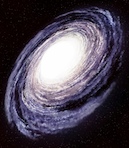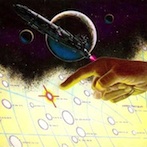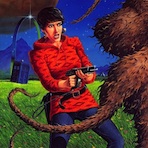Historical Background
Slan is justly considered A.E. van Vogt's finest novel, and the fact that it was his very first novel makes this achievement all the more noteworthy. Prior to this, his career as a science fiction writer was restricted mainly to "monster" type stories such as "Black Destroyer," "Discord in Scarlet," and "The Sea Thing." In each of these tales the monster was intelligent but a menace to mankind. Just when many readers of Astounding Science Fiction were becoming convinced that van Vogt was a one-track writer, Slan appeared, dramatically turning this theme on its head — the "monster" (here in the form of Jommy Cross) is intelligent but benevolent, and it is ordinary mankind that poses the menace. (Van Vogt himself admits this — see the 1980 Weinberg interview.) And just when the reader becomes convinced this is nothing more than a clever reversal of his usual theme, the apparent goodies-versus-baddies situation is revealed to be something far more complex, showing that neither the slans nor humanity are entirely good or entirely evil.
When the novel was first serialized in 1940, it quickly made its mark as a truly pioneering work in the science fiction genre, serving as a perfect example to other writers who wished to create more ambitious stories of their own. Aside from the realistically murky background filled with legends, garbled facts, lies, and counter- lies — just like the real world — van Vogt was one of the first writers to introduce tense and plausible political intrigue to science fiction. He laid the groundwork for later grandmasters such as Frank Herbert and Philip K. Dick, who honed science fiction's unique possibilities for intrigue to a fine art. And the novel's rich multilayered complexity was indicative of a genre that was rapidly becoming more sophisticated, largely thanks to John W. Campbell, editor of Astounding from September 1937 onward, who strove to push the limits of what science fiction could do. In line with this maturity, Slan was one of speculative literature's first serious treatments of telepathy and the role of the "superman" in society, the latter being a topic of much discussion during the late 19th and early 20th centuries. As such, Slan reflects the strong Darwinian ideas of the Eugenics Movement, in that it portrays a superior race evolving that is destined to replace (or rule) regular homo sapiens, a theme which is continued even today in works such as the recent X-Men films.
Although often criticized for his shortcomings as a writer, van Vogt was indisputably a craftsman who excelled in his own special areas of expertise. One of his greatest strengths as a writer lies in his ability to create short but effective transition scenes. In numerous places throughout the novel, he very nicely encapsulates entire years in a few terse paragraphs. This very difficult technique is sadly neglected among today's authors, who are perfectly content to rack up the word count with excessive detail, fleshing out parts of the story that would be far more effective when quickly summed up. And notably for a novel so short, Slan showcases van Vogt's fertile imagination — it contains a great deal of variety, switching locations quite often and with each setting being unique and interesting. There is also a nice blend of action, suspense, and even humor, with the unifying tale of Jommy's quest for truth offering ample opportunity for introspection and character development throughout the novel. And, of course, no discussion of van Vogt would be complete without touching on his ability to evoke in the reader a deep fascination and a sense of wonder that few before or since have been able to equal.
Page References
The Berkley printings of Slan are used for page references throughout this study, citing the source for each item of information presented.
I chose Berkley because they issued more printings of Slan than any other publisher (no fewer than 14 printings, as far as I'm aware!), making these copies far easier and cheaper to obtain than any other single edition. Also, unlike some publishers, all Berkley printings contain the same version of Slan (the 1968 version), and all were printed from the same plates so the pagination and layout is identical in every copy of the book they ever printed. All of these factors made Berkley ideal as a source for page references.
Acknowledgements
Writing this study came about through a peculiar chain of events. For a while during late 2006 and early 2007, I was working on an extensive guide to the fiction of A.E. van Vogt, which was to be called The Sevagram Handbook. (This project was ultimately abandoned as too time-consuming and of limited commercial viability. Since then, I've just decided to focus on the updated bibliography.) This guide would have given a summary for each work, as well as a list of characters, places, and aliens, and information on the different versions of each text. Since I re-read Slan in January 2007 in order to properly review Kevin J. Anderson's Slan Hunter, I ended up doing a "prototype" entry for Slan to experiment with the format I had in mind for the Handbook.
However, it wasn't until months later, when I was close to finishing my coverage of Slan, that I realized that this "entry" ran to 23,000 words and was far too detailed and bulky for the Handbook. I had become so engrossed in what I was doing that I failed to consider this "entry" in context. (Needless to say, I then worked on a more concise Handbook entry for Slan, which came to a much more manageable 1,500 words.) Fortunately, rather than letting all this effort go to waste, fellow van Vogt enthusiast Mark McSherry recommended that I offer this study as a downloadable e-booklet. This booklet was for sale from Booklocker.com for a couple of years before I decided to stop selling it and offer it for free on my website instead. And just recently (October 2011), I updated it as a series of HTML files for the new Sevagram website, making some minor corrections, revisions, and additions in the process.
So I'd like to thank Mark for his wonderful advice, and to acknowledge my debt to Jean-Marc Lofficier, Lance Parkin, and Lars Pearson, whose Doctor Who reference works inspired both this booklet and the (aborted) Sevagram Handbook. I'd also like to make note of my indebtedness to Michael McKinney, who suggested the idea for a detailed timeline and a list of gadgets... even though his suggestion was made years ago and for a completely different project!









